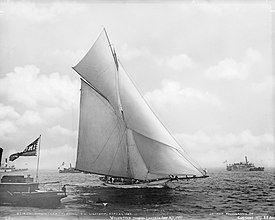
The America's Cup, informally known as the Auld Mug, is a trophy awarded in the sport of sailing. It is the oldest international competition still operating in any sport. America's Cup match races are held between two sailing yachts: one from the yacht club that currently holds the trophy and the other from the yacht club that is challenging for the cup. Matches are held several years apart on dates agreed between the defender and the challenger. There is no fixed schedule, but the races have generally been held every three to four years. The most recent America's Cup match took place in March 2021.

The New York Yacht Club (NYYC) is a private social club and yacht club based in New York City and Newport, Rhode Island. It was founded in 1844 by nine prominent sportsmen. The members have contributed to the sport of yachting and yacht design. As of 2001, the organization was reported to have about 3,000 members. Membership in the club is by invitation only. Its officers include a commodore, vice-commodore, rear-commodore, secretary and treasurer.

America was a 19th-century racing yacht and first winner of the America's Cup international sailing trophy.

Reliance was the 1903 America's Cup defender designed by Nat Herreshoff.
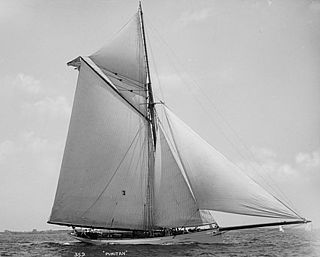
The Puritan was a 19th-century racing yacht and the 1885 America's Cup defender of the international sailing trophy.

Thistle was the unsuccessful Scottish challenger of the seventh America's Cup in 1887 against American defender Volunteer.

His Majesty's Yacht Britannia was a gaff-rigged cutter built in 1893 for RYS Commodore Albert Edward, Prince of Wales. She served both himself and his son King George V with a long racing career.

Edward Burgess (1848–1891) was an American yacht designer. Several of his boats won fame in the waters of the eastern United States.
The Pusey and Jones Corporation was a major shipbuilder and industrial-equipment manufacturer. Based in Wilmington, Delaware, it operated from 1848 to 1959.

Charles Ernest Nicholson was a British yacht designer.
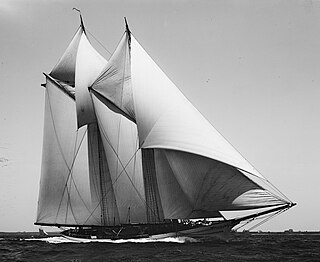
The Yampa was an American ocean-going cruising schooner yacht for pleasure use from 1887 to 1899. The yacht was originally built for Chester W. Chapin, a rail baron and U.S. Congressman from Massachusetts. It completed several ocean cruises with no accidents. It passed through several hands and ultimately was purchased by Kaiser Wilhelm II of Germany as a birthday present for his wife. He had another larger yacht built based on the design of the Yampa, which was named the Meteor III.

Meteor III was a schooner-rigged yacht built in the United States for the German Emperor Wilhelm II. She was third in a series of Meteor pleasure crafts Wilhelm had. Launched in 1902 it was the world's largest yacht built at the time. The yacht was mainly a pleasure craft, but did participate in races. She was christened by the daughter of US President Theodore Roosevelt, who was in attendance with Prince Henry of Prussia and two thousand spectators. The yacht had a 40-year career with twelve owners, some of who upgraded the yacht. She was requisitioned by the United States Navy during World War II for service and became the property of the United States government. Ultimately the yacht was sold out for scrap.
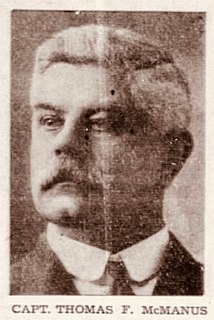
Thomas Francis McManus was a fish merchant who became a naval architect, responsible for introducing the shortened bowsprit and long stern overhang to give speed to his vessels. He was well known for revolutionizing the Gloucester fishing schooner. He made the fastest vessels of their type in the world and was honored on two continents for his skill as a naval architect. He became known as the "Father of the Fishermen's Races." 500 fishing schooners used his designs to improve speed. He was a friend of Sir Thomas Lipton and President Theodore Roosevelt.

The Widgeon was a 19th-century yacht and Sandy Hook pilot boat, built in 1855 by James R. & George Steers for Daniel Edgar of the New York Yacht Club and designed by George Steers. She came in 17th in an unsuccessful America’s Cup defense in 1870. Widgeon was sold in 1871 to a group of New York pilots to replace the John D. Jones, which sank in a collision with the steamer City of Washington. New York pilots condemned the Widgeon as unseaworthy in 1879, which sparked a fight for steam pilot-boat service. In 1883 a decision was affirmed by the Supreme Court and the Board of Commissioners of Pilots that pilot boats could be "propelled" by steam.

The Gracie was a 19th-century racing sloop yacht built in 1868 by James E. Smith shipyard at Nyack, New York. She raced the America's Cup defender Mischief in the trails off Sandy Hook in 1881. Gracie raced at the New York Yacht Club, Atlantic Yacht Club and other eastern yacht clubs. After a 42 year career in racing, she was sold in 1909 and converted to a freight boat sailing from Milton Point, off Long Island to New York.
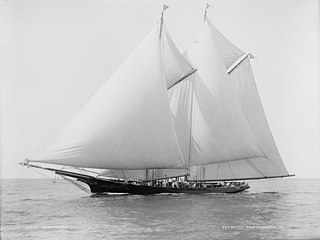
The Dauntless was a 19th-century wooden yacht schooner, designed and built in 1866 by Forsyth & Morgan at Mystic Bridge, Connecticut, and owned and sailed by noted yachtsmen, among them James Gordon Bennett Jr. and Caldwell Hart Colt. She was first called the L'Hirondelle and later renamed the Dauntless. The Dauntless was in three Trans-Atlantic matches for the New York Yacht Club. She came in fourth in an unsuccessful America’s Cup defense in 1870.

The Idler was a 19th-century schooner-yacht built in 1864 by Samuel Hartt Pook from Fairhaven, Connecticut and owned by yachtsman Thomas C. Durant. She was one of the fastest yachts in the New York squadron. Idler came in 2nd place in the America’s Cup defense in 1870. She was sold as a racing yacht several times before she capsized and sank in 1900.

The Madeleine was a 19th-century racing schooner-yacht built in 1868 by David Kurby in Rye, New York and owned by Commodore Jacob B. Voorhis. Madeleine was the winner of the America's Cup in 1876 and an American defender in the 1870 America's Cup. She won the two most desired trophies reserved for schooners, the Bennett and the Douglas Cups. In 1911, the Madeleine was dismantled and sunk at the mouth of the Hillsborough River, Florida.

The J. Henry Edmunds was a 19th-century pilot schooner built in 1887 in Brooklyn, New York for Philadelphia pilots. She sank in 1892 and a second Edmunds was built in 1893, which lasted thirty-five years before she sank in bad weather outside Cape Henlopen in 1928. She was the last schooner-rigged pilot boat in the Delaware Bay.
Camper and Nicholson was a yacht design and manufacturing company based in Gosport, England, for over two hundred years, constructing many significant vessels, such as Gipsy Moth IV and Prince Philip's yacht Bloodhound. Its customers included Thomas Sopwith, William Kissam Vanderbilt II and George Spencer-Churchill, 6th Duke of Marlborough. Its yachts competed in The America's Cup, The Fastnet Race, the Olympics, the Ocean Race and many other yacht races.
